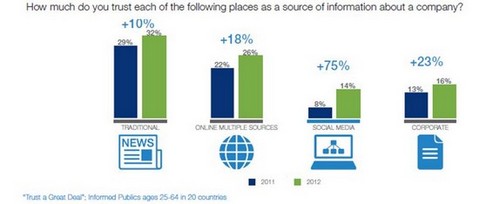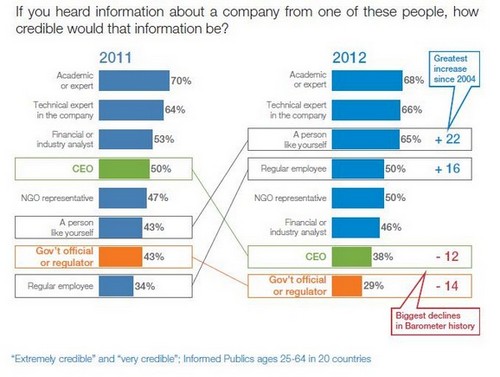
Guest post by Todd Defren. Todd is CEO at SHIFT Communications, a globally-recognized social media and public relations speaker and author of the PR-Squared blog.
In today’s communications landscape, Paid (advertising), Earned (PR) and Owned (branded) Media are converging like never before.
Of these media types, which is the most valuable?
Not “the most expensive.” The most valuable.
If what you value most as a brand is the trust of consumers and prospects, then the answer is obvious: Earned Media is far and away the most effective influencer of consumer trust.
Of course, historically it’s also been the most difficult to measure — and of the three types of media mentioned above, despite being the most valuable, Earned Media also bears the dubious distinctions of also being the least controllable and least expensive. Thus the “red-headed stepchild” syndrome that’s attached itself to the PR industry since the Mad Men days.
However, the value of Earned Media is only growing, especially if by “earned media” you include in your definition the unbiased, 3rd party citations of consumers themselves, a.k.a. Word of Mouth. And why wouldn’t you include “Social” under the “Earned Media” banner?
Historically, most people think of Earned Media purely as “traditional PR results in mainstream media.” Even if we stopped there, it wouldn’t be a terrible thing, as it is demonstrably true that in today’s deluge of content, the 3rd party, unbiased and credentialed voice of mainstream media is more critical than ever. Traditional media, by far, is the most trusted by consumers. However, at SHIFT we embrace the idea that Earned Media also spawns from the Social realm (you can see below that it’s a fast growing trust factor). After all, if an independent consumer says something nice about a brand (on Twitter, Yelp, etc.), it constitutes an earned opinion about the company; it was not paid for like an advertisement; it was not sponsored as branded content:

See how in the Edelman research above, “traditional” news is not only the most trusted source of information, but also is growing? See how trust in Social Media, a.k.a. trust in “someone like me” is growing at the fastest rate? The latter point is driven home even more, below:

So, if the research is accurate regarding the source of consumer trust — Earned Media related to mainstream PR results and to the Social Media activities of independent 3rd party consumers — we are in pretty good shape when we promote the idea that Earned Media is positioned to be the most valuable component of a client’s communications strategy.
In other words, this ain’t just the PR guy being biased. This approach is based on research.
After all, why would you promote a strategy based on media that is not trustworthy? Just because it costs more money to produce or place? Pshaw! Now, I am not suggesting that Advertising and Branded content are unimportant to the marketing mix, only thatEarned Media has more implicit trust across consumers, and that its role cannot be sidelined or dismissed.
Now: how might this work in practice? Let this graphic be your guide as you walk through the steps below:
 THE EARNED MEDIA HUB STRATEGY:
THE EARNED MEDIA HUB STRATEGY:
You (the client) have an idea; you have a product or service to sell … in this example, obviously, you’ve tapped SHIFT to help out!
1. RESEARCH: SHIFT conducts research on the industry opportunity, the competition, the social media and mainstream media buzz, and, the influencers in the space. We determine what types of content are most often shared across the social graphs of your stakeholders.
2. MESSAGING: With these findings, we conduct a messaging session for the corporation and/or product, coming up with clear points of differentiation that also reflect your brand and culture — and which, critically, we can “sell” to the media, to prospective customers, and the world.
3. CONTENT CREATION: On an ongoing basis we create content in support of the message — maybe it’s a video, or an infographic series, or a microsite, etc. Maybe it’s as simple as an email pitch to a handful of top reporters. Sometimes that’s enough.
4. SEO & OWNED MEDIA: As appropriate, the zingy new content is SEO-optimized and shared across your company’s owned channels: your blog, Twitter, your Facebook page, your Google+ page, etc. It pings across the social nets of your current fans and friends.
5. EARNED MEDIA: More importantly, SHIFT is working to ensure that content is motivating influencers to share that content, whether in the mainstream media or on influential industry or consumer blogs, and/or across individual Social Media influencers’ social graphs … Hey! What’s that, again? SHIFT nailed down an article about the company in USA TODAY!? Awesome. That’s third party, credentialed and unbiased credibility from a respected source with huge readership. It doesn’t get much better. Let’s call this “The Big Hit.” In the old days, that’s when we’d stop. Maybe the client would post the USA TODAY article on their site, but that’s typically as far as it would go … Leading inevitably to the “what have you done for me lately?” syndrome that has plagued the industry. Today, at SHIFT, that earned media “Big Hit” is where things start to get interesting.
6. EARNED MEDIA > OWNED & PAID MEDIA: In addition to sharing The Big Hit across your owned social channels (Facebook Timeline, Twitter, corporate blog, etc.), we’re going to advocate making sure that millions of additional eyeballs view this awesome content, via paid promotion strategies.
7. EARNED > PAID: Let’s syndicate the content. We can guarantee that The Big Hit you got at USA TODAY is also seen by readers of contextually-related articles on other mainstream media sites, ranging from CNN and Newsweek to TMZ and PC Magazine. We even perform A/B testing on the headlines to further boost relevant traffic. (By the way, yes, mainstream publishers love this approach: while you may be featuring a media competitor’s content, they will get paid for the link. And the reporter who wrote the original piece certainly appreciates it when you send millions of new readers their way!)
8. MORE EARNED > OWNED & PAID: Now, let’s take the “Awesome story! Love this product!”Facebook post by an influencer who “liked” The Big Hit and turn that post into a Sponsored Story that pings their social graph and beyond. Now you have the added validation of an influential kudos attached to that already-awesome Big Hit! If that kudo happened on Twitter, instead? Cool: we can create a Promoted Tweet, featuring the influencer but pointing readers to The Big Hit itself. Again, you’re using Paid Media to drive eyeballs to Earned Media, earning a double-whammy of credibility.
9. EVEN MORE EARNED > OWNED & PAID: And if we didn’t note an influencer giving the thumb’s-up to The Big Hit? No problem. It just means we might use more conventional social advertising strategies to drive traffic to that earned media hit.
10. AND IT CONTINUES! EARNED > OWNED & PAID: It need not end there. Some clients understandably worry about sending traffic to USA TODAY vs. their own website. But once prospects read that great USA TODAY hit and come for a website visit, we can create banner ads (or use clients’ current inventory) and deploy Ad Re-Targeting technology based on those website visits. In laymen’s terms: if the prospect visited your website, we can serve them targeted banner ads across a vast network of external, mainstream media sites, reminding them throughout their subsequent surfing of their original interest in your company.
See how the credibility-boosting power of Earned Media can become the hub of a broader marketing communications strategy?
It wasn’t possible before. It’s possible now. All you need is a different way of thinking. It’s not all about Social for Social’s sake. It’s about taking full advantage of Media Convergence, and using the most valuable, trusted content assets as the central spoke in your strategy.
Learn more in Todd’s upcoming webinar which will expand on the above points and more!
![]()

